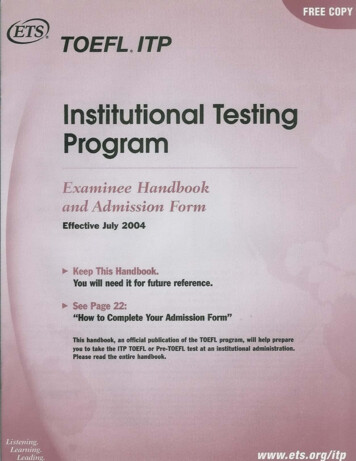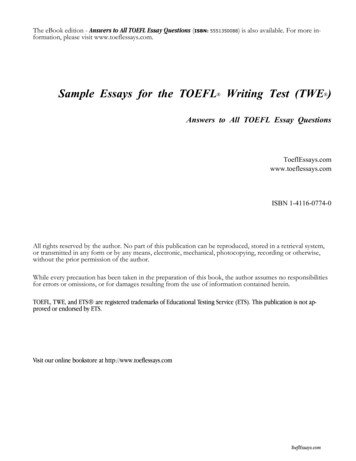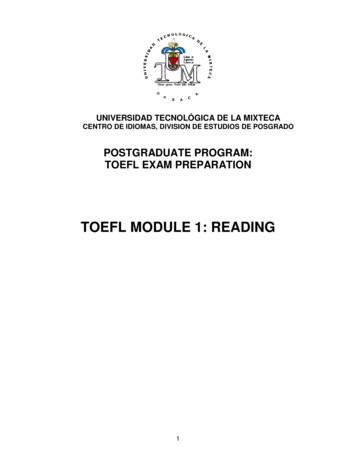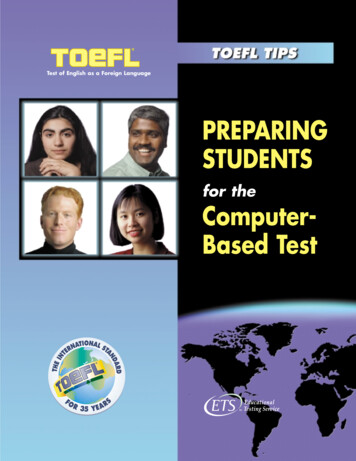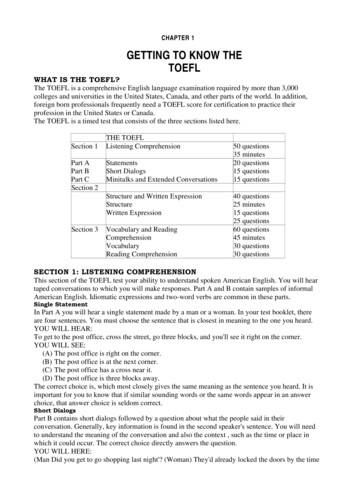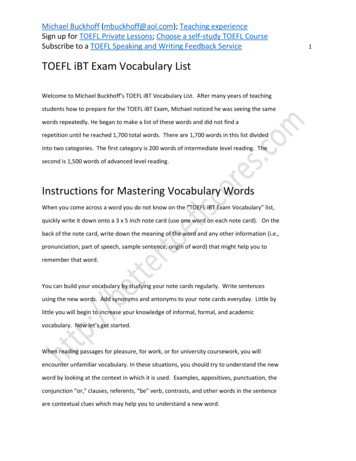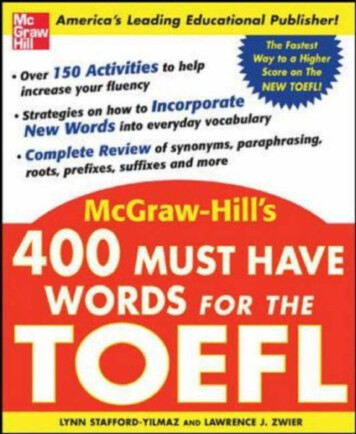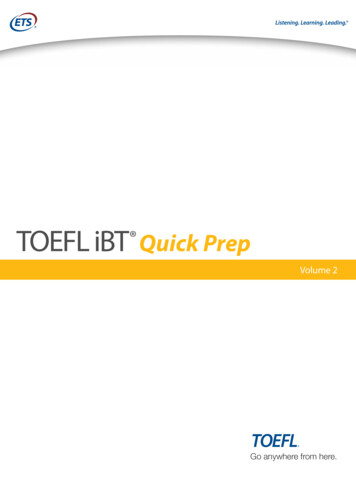
Transcription
A Collection ofTOEFLReadingComprehensionTests
ContentPRACTICE TEST 01 .3PRACTICE TEST 02 .11PRACTICE TEST 03 .18PRACTICE TEST 04 .26PRACTICE TEST 05 .34PRACTICE TEST 06 .42PRACTICE TEST 07 .50PRACTICE TEST 08 .57PRACTICE TEST 09 .65PRACTICE TEST 10 .73PRACTICE TEST 11 .81PRACTICE TEST 12 .89PRACTICE TEST 13 .97PRACTICE TEST 14 .105ANSWER KEY .113
PRACTICE TEST 01May 2004Question 1-10All mammals feed their young. Beluga whale mothers, for example, nurse their calves forsome twenty months, until they are about to give birth again and their young are able tofind their own food. The behavior of feeding of the young is built into the reproductiveLine system. It is a nonelective part of parental care and the defining feature of a mammal, the(5)most important thing that mammals-- whether marsupials, platypuses, spiny anteaters, orplacental mammals -- have in common.(10)(15)(20)(25)But not all animal parents, even those that tend their offspring to the point of hatching orbirth, feed their young. Most egg-guarding fish do not, for the simple reason that theiryoung are so much smaller than the parents and eat food that is also much smaller thanthe food eaten by adults. In reptiles, the crocodile mother protects her young after theyhave hatched and takes them down to the water, where they will find food, but she doesnot actually feed them. Few insects feed their young after hatching, but some make otherarrangement, provisioning their cells and nests with caterpillars and spiders that they haveparalyzed with their venom and stored in a state of suspended animation so that theirlarvae might have a supply of fresh food when they hatch.For animals other than mammals, then, feeding is not intrinsic to parental care. Animalsadd it to their reproductive strategies to give them an edge in their lifelong quest fordescendants. The most vulnerable moment in any animal's life is when it first finds itselfcompletely on its own, when it must forage and fend for itself. Feeding postpones thatmoment until a young animal has grown to such a size that it is better able to cope. Youngthat are fed by their parents become nutritionally independent at a much greater fractionof their full adult size. And in the meantime those young are shielded against the vagariesof fluctuating of difficult-to-find supplies. Once a species does take the step of feeding itsyoung, the young become totally dependent on the extra effort. If both parents areremoved, the young generally do no survive.1. What does the passage mainly discuss?(A) The care that various animals give to their offspring.(B) The difficulties young animals face in obtaining food.(C) The methods that mammals use to nurse their young.(D) The importance among young mammals of becoming independent.2. The author lists various animals in line 5 to(A) contrast the feeding habits of different types of mammals(B) describe the process by which mammals came to be defined(C) emphasize the point that every type of mammal feeds its own young(D) explain why a particular feature of mammals is nonelective3. The word "tend" in line 7 is closest in meaning to(A) sit on(B) move(C) notice(D) care for4. What can be inferred from the passage about the practice of animal parents feeding their young?(A) It is unknown among fish.(B) It is unrelated to the size of the young.(C) It is dangerous for the parents.(D) It is most common among mammals.5. The word "provisioning" in line 13 is closest in meaning to(A) supplying(B) preparing(C) building3(D) expanding
PRACTICE TEST 01 – May 20046. According to the passage, how do some insects make sure their young have food?(A) By storing food near their young.(B) By locating their nests or cells near spiders and caterpillars.(C) By searching for food some distance from their nest.(D) By gathering food from a nearby water source.7. The word "edge" in line 17 is closest in meaning to(A) opportunity(B) advantage(C) purpose(D) rest8. The word "it" in line 20 refers to(A) feeding(B) moment(C) young animal(D) size9. According to the passage, animal young are most defenseless when(A) their parents are away searching for food(B) their parents have many young to feed(C) they are only a few days old(D) they first become independent10. The word "shielded" in line 22 is closest in meaning to(A) raised(B) protected(C) hatched(D) valuedQuestion 11-21Printmaking is the generic term for a number of processes, of which woodcut andengraving are two prime examples. Prints are made by pressing a sheet of paper (or othermaterial) against an image-bearing surface to which ink has been applied. When the paperis removed, the image adheres to it, but in reverse.Line(5)(10)(15)(20)(25)The woodcut had been used in China from the fifth century A.D. for applying patterns totextiles. The process was not introduced into Europe until the fourteenth century, first fortextile decoration and then for printing on paper. Woodcuts are created by a relief process;first, the artist takes a block of wood, which has been sawed parallel to the grain, covers itwith a white ground, and then draws the image in ink. The background is carved away,leaving the design area slightly raised. The woodblock is inked, and the ink adheres to theraised image. It is then transferred to damp paper either by hand or with a printing press.Engraving, which grew out of the goldsmith's art, originated in Germany and northern Italyin the middle of the fifteenth century. It is an intaglio process (from Italian intagliare, "tocarve"). The image is incised into a highly polished metal plate, usually copper, with acutting instrument, or burin. The artist inks the plate and wipes it clean so that some inkremains in the incised grooves. An impression is made on damp paper in a printing press,with sufficient pressure being applied so that the paper picks up the ink.Both woodcut and engraving have distinctive characteristics. Engraving lends itself tosubtle modeling and shading through the use of fine lines. Hatching and cross-hatchingdetermine the degree of light and shade in a print. Woodcuts tend to be more linear, withsharper contrasts between light and dark. Printmaking is well suited to the production ofmultiple images. A set of multiples is called an edition. Both methods can yield severalhundred good-quality prints before the original block or plate begins to show signs of wear.Mass production of prints in the sixteenth century made images available, at a lower cost,to a much broader public than before.4
TOEFL Reading Comprehension11. What does the passage mainly discuss?(A) The origins of textile decoration(C) Two types of printmaking(B) The characteristics of good-quality prints(D) Types of paper used in printmaking12. The word "prime" in line 2 is closest in meaning to(A) principal(B) complex(C) general(D) recent14. The word "incised" in line 14 is closest in meaning to(A) burned(B) cut(C) framed(D) baked13. The author's purposes in paragraph 2 is to describe(A) the woodcuts found in China in the fifth century(B) the use of woodcuts in the textile industry(C) the process involved in creating a woodcut(D) the introduction of woodcuts to Europe15. Which of the following terms is defined in the passage/(A) "patterns" (line 5)(B) "grain" (line 8)(C) "burin" (line 15)(D) "grooves" (line 16)16. The word "distinctive" in line 18 is closest in meaning to(A) unique(B) accurate(C) irregular(D) similar17. According to the passage, all of the following are true about engraving EXCEPT that it(A) developed from the art of the goldsmiths(B) requires that the paper be cut with a burin(C) originated in the fifteenth century(D) involves carving into a metal plate18. The word "yield" in line 22 is closest in meaning to(A) imitate(B) produce(C) revise(D) contrast19. According to the passage, what do woodcut and engraving have in common?(A) Their designs are slightly raised.(B) They achieve contrast through hatching and cross-hatching.(C) They were first used in Europe.(D) They allow multiple copies to be produced from one original.20. According to the author, what made it possible for members of the general public to own prints in thesixteenth century?(A) Prints could be made at low cost.(B) The quality of paper and ink had improved.(C) Many people became involved in the printmaking industry.(D) Decreased demand for prints kept prices affordable.21. According to the passage, all of the following are true about prints EXCEPT that they(A) can be reproduced on materials other than paper(B) are created from a reversed image(C) show variations between light and dark shades(D) require a printing press5
PRACTICE TEST 01 – May 2004Questions 22-31The first peoples to inhabit what today is the southeastern United States sustainedthemselves as hunters and gathers. Sometimes early in the first millennium A.D., however,they began to cultivate corn and other crops. Gradually, as they became more skilled atLine gardening, they settled into permanent villages and developed a rich culture, characterized(5)by the great earthen mounds they erected as monuments to their gods and as tombs fortheir distinguished dead. Most of these early mound builders were part of theAdena-Hopewell culture, which had its beginnings near the Ohio River and takes its namefrom sites in Ohio. The culture spread southward into the present-day states of Louisiana,Alabama, Georgia, and Florida. Its peoples became great traders, bartering jewellery,(10) pottery, animal pelts, tools, and other goods along extensive trading networks thatstretched up and down eastern North America and as far west as the Rocky Mountains.(15)(20)About A.D. 400, the Hopewell culture fell into decay. Over the next centuries, it wassupplanted by another culture, the Mississippian, named after the river along which manyof its earliest villages were located. This complex civilization dominated the Southeast fromabout A.D. 700 until shortly before the Europeans began arriving in the sixteenth century.At the peak of its strength, about the year 1200, it was the most advanced culture in NorthAmerica. Like their Hopewell predecessors, the Mississippians became highly skilled atgrowing food, although on a grander scale. They developed an improved strain of corn,which could survive in wet soil and a relatively cool climate, and also learned to cultivatebeans. Indeed, agriculture became so important to the Mississippians that it becameclosely associated with the Sun – the guarantor of good crops. Many tribes calledthemselves "children of the Sun" and believed their omnipotent priest-chiefs weredescendants of the great sun god.Although most Mississippians lived in small villages, many others inhabited large towns.(25) Most of these towns boasted at least one major flat-topped mound on which stood atemple that contained a sacred flame. Only priests and those charged with guarding theflame could enter the temples. The mounds also served as ceremonial and trading sites,and at times they were used as burial grounds.22. What does the passage mainly discuss?(A) The development of agriculture(B) The locations of towns and villages(C) The early people and cultures of the United States(D) The construction of burial mounds23. Which of the following resulted from the rise of agriculture in the southeastern United States?(A) The development of trade in North America(B) The establishment of permanent settlements(C) Conflicts with other Native American groups over land(D) A migration of these peoples to the Rocky Mountains.24. What does the term "Adena-Hopewell" (line 7) designate?(A) The early locations of the Adena-Hopewell culture(B) The two most important nations of the Adena-Hopewell culture(C) Two former leaders who were honored with large burial mounds.(D) Two important trade routes in eastern North America25. The word "bartering" in line 9 is closest in meaning to(A) producing(B) exchanging(C) transporting6(D) loading
TOEFL Reading Comprehension26. The word "supplanted" in line 13 is closest in meaning to(A) conquered(B) preceded(C) replaced(D) imitated27. According to the passage, when did the Mississippian culture reach its highest point of development?(A) About A.D. 400(B) Between A.D. 400 and A.D. 700(C) About A.D. 1200(D) In the sixteenth century28. According to the passage, how did the agriculture of the Mississippians differ from that of their Hopewellpredecessors?(A) The Mississippians produced more durable and larger crops of food.(B) The Mississippians sold their food to other groups.(C) The Mississippians could only grow plants in warm, dry climates.(D) The Mississippians produced special foods for their religious leaders.29. Why does the author mention that many Mississippians tribes called themselves "children of the Sun"(line 22)?(A) To explain why they were obedient to their priest-chiefs.(B) To argue about the importance of religion in their culture.(C) To illustrate the great importance they placed on agriculture.(D) To provide an example of their religious rituals.30. The phrase "charged with" in line 26 is closest in meaning to(A) passed on(B) experienced at(C) interested in(D) assigned to31. According to the passage, the flat-topped mounds in Mississippian towns were used for all of thefollowing purposes EXCEPT(A) religious ceremonies(B) meeting places for the entire community(C) sites for commerce(D) burial sitesQuestion 32-40Overland transport in the United States was still extremely primitive in 1790. Roads werefew and short, usually extending from inland communities to the nearest river town orseaport. Nearly all interstate commerce was carried out by sailing ships that served theLine bays and harbors of the seaboard. Yet, in 1790 the nation was on the threshold of a new(5)era of road development. Unable to finance road construction, states turned for help toprivate companies, organized by merchants and land speculators who had a personalinterest in improved communications with the interior. The pioneer in this move was thestate of Pennsylvania, which chartered a company in 1792 to construct a turnpike, a roadfor the use of which a toll, or payment, is collected, from Philadelphia to Lancaster. The(10) legislature gave the company the authority to erect tollgates at points along the roadwhere payment would be collected, though it carefully regulated the rates. (The states hadunquestioned authority to regulate private business in this period.)(15)(20)The company built a gravel road within two years, and the success of the Lancaster Pikeencouraged imitation. Northern states generally relied on private companies to build theirtoll roads, but Virginia constructed a network at public expense. Such was the roadbuilding fever that by 1810 New York alone had some 1,500 miles of turnpikes extendingfrom the Atlantic to Lake Erie.Transportation on these early turnpikes consisted of freight carrier wagons and passengerstagecoaches. The most common road freight carrier was the Conestoga wagon, a vehicledeveloped in the mid-eighteenth century by German immigrants in the area around7
PRACTICE TEST 01 – May 2004(25)Lancaster, Pennsylvania. It featured large, broad wheels able to negotiate all but thedeepest ruts and holes, and its round bottom prevented the freight from shifting on a hill.Covered with canvas and drawn by four to six horses, the Conestoga wagon rivaled the logcabin as the primary symbol of the frontier. Passengers traveled in a variety ofstagecoaches, the most common of which had four benches, each holding three persons.It was only a platform on wheels, with no springs; slender poles held up the top, andleather curtains kept out dust and rain.32. Paragraph 1 discusses early road building in the United States mainly in terms of the(A) popularity of turnpikes(B) financing of new roads(C) development of the interior(D) laws governing road use33. The word "primitive" in line 1 is closest in meaning to(A) unsafe(B) unknown(C) inexpensive(D) undeveloped34. In 1790 most roads connected towns in the interior of the country with(A) other inland communities(B) towns in other states(C) river towns or seaports(D) construction sites35. The phrase "on the threshold of" in line 4 and 5 is closest in meaning to(A) in need of(B) in place of(C) at the start of(D) with the purpose of36. According to the passage, why did states want private companies to help with road building?(A) The states could not afford to build roads themselves.(B) The states were not as well equipped as private companies.(C) Private companies could complete roads faster than the states.(D) Private companies had greater knowledge of the interior.37. The word "it" in line 11 refers to(A) legislature(B) company(C) authority38. The word "imitation" in line 14 is closest in meaning to(A) investment(B) suggestion(C) increasing(D) payment(D) copying39. Virginia is mentioned as an example of a state that(A) built roads without tollgates(B) built roads with government money(C) completed 1,500 miles of turnpikes in one year(D) introduced new law restricting road use40. The "large, broad wheels" of the Conestoga wagon are mentioned in line 21 as an example of a featureof wagons that was(A) unusual in mid-eighteenth century vehicles(B) first found in Germany(C) effective on roads with uneven surfaces(D) responsible for frequent damage to freight8
TOEFL Reading ComprehensionQuestion 41- 50In Death Valley, California, one of the hottest, most arid places in North America, there ismuch salt, and salt can damage rocks impressively. Inhabitants of areas elsewhere, wherestreets and highways are salted to control ice, are familiar with the resulting rust andLine deterioration on cars. That attests to the chemically corrosive nature of salt, but it is not(5)the way salt destroys rocks. Salt breaks rocks apart principally by a process called crystalprying and wedging. This happens not by soaking the rocks in salt water, but by moisteningtheir bottoms with salt water. Such conditions exist in many areas along the eastern edgeof central Death Valley. There, salty water rises from the groundwater table by capillaryaction through tiny spaces in sediment until it reaches the surface.(10)(15)(20)(25)Most stones have capillary passages that suck salt water from the wet ground. DeathValley provides an ultra-dry atmosphere and high daily temperatures, which promoteevaporation and the formation of salt crystals along the cracks or other openings withinstones. These crystals grow as long as salt water is available. Like tree roots breaking up asidewalk, the growing crystals exert pressure on the rock and eventually pry the rock apartalong planes of weakness, such as banding in metamorphic rocks, bedding in sedimentaryrocks, or preexisting or incipient fractions, and along boundaries between individualmineral crystals or grains. Besides crystal growth, the expansion of halite crystals (the sameas everyday table salt) by heating and of sulfates and similar salts by hydration cancontribute additional stresses. A rock durable enough to have withstood natural conditionsfor a very long time in other areas could probably be shattered into small pieces by saltweathering within a few generations.The dominant salt in Death Valley is halite, or sodium chloride, but other salts, mostlycarbonates and sulfates, also cause prying and wedging, as does ordinary ice. Weatheringby a variety of salts, though often subtle, is a worldwide phenomenon. Not restricted toarid regions, intense salt weathering occurs mostly in salt-rich places like the seashore,near the large saline lakes in the Dry Valleys of Antarctica, and in desert sections ofAustralia, New Zealand, and central Asia.41. What is the passage mainly about?(A) The destructive effects of salt on rocks.(B) The impressive salt rocks in Death Valley.(C) The amount of salt produced in Death Valley.(D) The damaging effects of salt on roads and highways.42. The word "it" in line 9 refers to(A) salty water(B) groundwater table(C) capillary action(D) sediment43. The word "exert" in line 14 is closest in meaning to(A) put(B) reduce(C) replace(D) control44. In lines 13-17, why does the author compare tree roots with growing salt crystals?(A) They both force hard surfaces to crack.(B) They both grow as long as water is available.(C) They both react quickly to a rise in temperature.(D) They both cause salty water to rise from the groundwater table.9
PRACTICE TEST 01 – May 200445. In lines 17-18, the author mentions the "expansion of halite crystals.by heating and of sulfates andsimilar salts by hydration" in order to(A) present an alternative theory about crystal growth(B) explain how some rocks are not affected by salt(C) simplify the explanation of crystal prying and wedging(D) introduce additional means by which crystals destroy rocks46. The word "durable" in line 19 is closest in meaning to(A) large(B) strong(C) flexible(D) pressured47. The word "shattered" in line 20 is closest in meaning to(A) arranged(B) dissolved(C) broken apart(D) gathered together48. The word "dominant" in line 22 is closest in meaning to(A) most recent(B) most common(C) least available(D) least damaging49. According to the passage, which of the following is true about the effects of salts on rocks?(A) Only two types of salts cause prying and wedging.(B) Salts usually cause damage only in combination with ice.(C) A variety of salts in all kinds of environments can cause weathering.(D) Salt damage at the seashore is more severe than salt damage in Death Valley.50. Which of the following can be inferred from the passage about rocks that are found in areas where ice iscommon?(A) They are protected from weathering.(B) They do not allow capillary action of water.(C) They show similar kinds of damage as rocks in Death Valley.(D) They contain more carbonates than sulfates.10
PRACTICE TEST 02January 2003Questions 1-10By far the most important United States export product in the eighteenth andnineteenth centuries was cotton, favored by the European textile industry over flax orwool because it was easy to process and soft to tile touch. Mechanization of spinningLine and weaving allowed significant centralization and expansion in the textile industry during(5)this period, and at the same time the demand for cotton increased dramatically. Americanproducers were able to meet this demand largely because of tile invention of the cotton ginby Eli Whitney in 1793. Cotton could be grown throughout the South, but separating thefiber – or lint – from the seed was a laborious process. Sea island cotton was relativelyeasy to process by hand, because its fibers were long and seeds were concentrated at the(10) base of the flower, but it demanded a long growing season, available only along thenation's eastern seacoast. Short-staple cotton required a much shorter growing season,but the shortness of the fibers and their mixture with seeds meant that a worker couldhand-process only about one pound per day. Whitney's gin was a hand-powered machinewith revolving drums and metal teeth to pull cotton fibers away from seeds. Using the gin,(15) a worker could produce up to 50 pounds of lint a day. The later development of largergins, powered by horses, water, or steam, multiplied productivity further.(20)(25)The interaction of improved processing and high demand led to the rapid spread ofthe cultivation of cotton and to a surge in production. It became the main Americanexport, dwarfing all others. In 1802, cotton composed 14 percent of total Americanexports by value. Cotton had a 36 percent share by 1810 and over a 50 percent sharein 1830. In 1860, 61 percent of the value of American exports was represented by cotton.In contrast, wheat and wheat flour composed only 6 percent of the value of Americanexports in that year. Clearly, cotton was king in the trade of the young republic. Thegrowing market for cotton and other American agricultural products led to anunprecedented expansion of agricultural settlement, mostly in the eastern half of theUnited States---west of the Appalachian Mountains and east of the Mississippi River.1. The main point of the passage is that the eighteenth and nineteenth centuries were a time when(A) the European textile industry increased its demand for American export products(B) mechanization of spinning and weaving dramatically changed the textile industry(C) cotton became a profitable crop but was still time-consuming to process(D) cotton became the most important American export product2. The word "favored" in line 2 is closest in meaning to(A) preferred(B) recommended(C) imported(D) included3. All of the following are mentioned in the passage as reasons for the increased demand for cotton EXCEPT(A) cotton's softness(B) cotton's ease of processing(C) a shortage of flax and wool(D) the growth that occurred in the textile industry.4. The word "laborious" in line 8 is closest in meaning to(A) unfamiliar(B) primitive(C) skilled5. According to the passage, one advantage of sea island cotton was its(A) abundance of seeds(B) long fibers11(D) difficult
PRACTICE TEST 02 – January 2003(C) long growing season(D) adaptability to different climates6. Which of the following can be inferred from the passage about cotton production in the United States afterthe introduction of Whitney's cotton gin?(A) More cotton came from sea island cotton plants than before.(B) More cotton came from short-staple cotton plants than before.(C) Most cotton produced was sold domestically.(D) Most cotton produced was exported to England.7. The word "surge" in line 18 is closest in meaning to(A) sharp increase(C) important change(B) sudden stop(D) excess amount8. The author mentions "wheat and wheat flour" in line 22 in order to(A) show that Americans exported more agricultural products than they imported.(B) show the increase in the amount of wheat products exported.(C) demonstrate the importance of cotton among American export products.(D) demonstrate that wheat farming was becoming more profitable.9. The word "unprecedented" in line 25 is closest in meaning to(A) slow(B) profitable(C) not seen before(D) never explained10. According to the passage, the Mississippi River was(A) one of the boundaries of a region where new agricultural settlement took place(B) a major source of water for agricultural crops(C) the primary route by which agricultural crops were transported(D) a main source of power for most agricultural machineryQuestions 11-19The origins of nest-building remain obscure, but current observation of nest-buildingactivities provide evidence of their evolution. Clues to this evolutionary process can befound in the activities of play and in the behavior and movements of birds during mating,Line such as incessant pulling at strips of vegetation or scraping of the soil. During the early(5) days of the reproductive cycle, the birds seem only to play with the building materials. Inpreparation for mating, they engage in activities that resemble nest-building, and continuethese activities throughout and even after the mating cycle. Effective attempts at constructionoccur only after mating.(10)(15)(20)Although nest-building is an instinctive ability, there is considerable adaptability inboth site selection and use of materials, especially with those species which build quiteelaborate constructions. Furthermore, some element of learning is often evident sinceyounger birds do not build as well as their practiced elders. Young ravens, for example,first attempt to build with sticks of quite unsuitable size, while a jackdaw's first nestincludes virtually any movable object. The novelist John Steinbeck recorded the contentsof a young osprey nest built in his garden, which included three shirts, a bath towel, andone arrow.Birds also display remarkable behavior in collecting building materials. Crows havebeen seen to tear off stout green twigs, and sparrowhawks will dive purposefully onto abranch until it snaps and then hang upside down to break it off. Golden eagles, overgenerations of work, construct enormous nests. One of these, examined after it had beendislodged by high winds, weighed almost two tons and included foundation branchesalmost two meters long. The carrying capacity of the eagle
TOEFL Reading Comprehension 5 11. What does the passage mainly discuss? (A) The origins of textile decoration (B) The characteristics of good-quality prints (C) Two types of printmaking (D) Types of paper used in printmaking 12. The word "prime" in line 2 is closest in meanin
